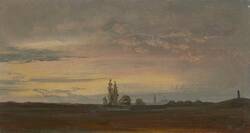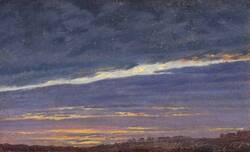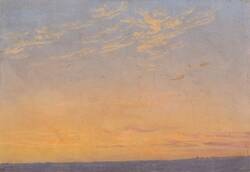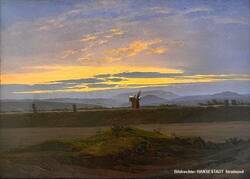In 1818, Friedrich became friends with a fellow artist in Dresden who worked in a very different way from himself – Johann Christian Dahl from Norway. Here, you can see four of Dahl’s small landscapes and cloud studies.
With his easel and paintbox, Dahl went into the countryside painting from nature directly onto the canvas without preliminary drawings. In contrast, Friedrich only ever sketched from nature. His sketches were a resource he could turn into paintings in his studio. There he left nothing to chance. After covering his canvas in detailed preliminary drawings as a foundation, he built up his oil painting slowly and carefully.
He must have been rather puzzled to see his friend Dahl bringing finished pictures back from his painting trips. In any case, Friedrich soon started to experiment with this way of working. You can see the results further to the right. In the row of three pictures, the works in the centre and on the right are Friedrich’s oil studies of momentary impressions of the sky. The two works seem incredibly modern, especially in their focus on air and light rendered in paint. Here, the horizon is just secondary.
Friedrich was not to become a plein air painter. However, his artistic dialogue with Dahl did bear fruit in other ways. He significantly expanded his spectrum of colours, as is evident not just in the two oil studies, but equally in the left-hand picture in the row of three – Friedrich’s Morning Landscape from around 1820. In terms of colour, this work, with its vibrant orange and violet tones, is one of Friedrich’s most radical paintings.
Further Media
- Location & Dating
- 1820/30
- Material & Technique
- Oil on canvas
- Dimenions
- 16 x 24,5 cm
- Museum
- Galerie Neue Meister
- Inventory number
- Gal.-Nr. 2206 A





